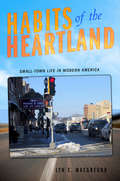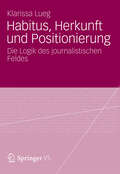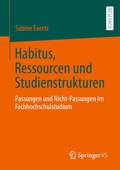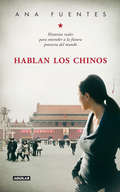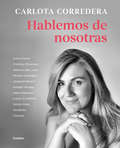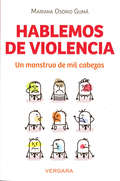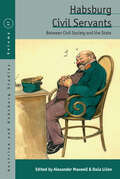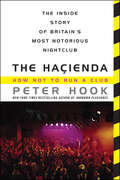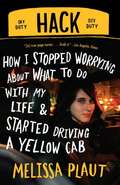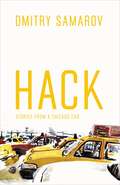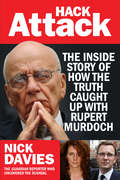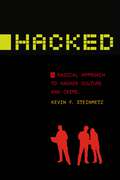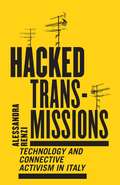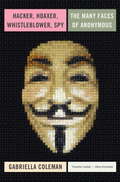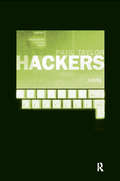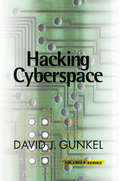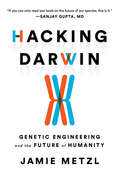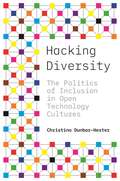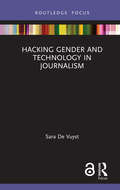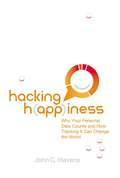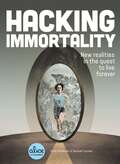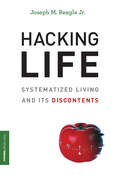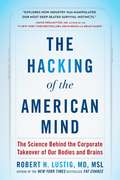- Table View
- List View
Habits of Compassion: Irish Catholic Nuns and the Origins of New York's Welfare System, 1830-1920 (Women, Gender, and Sexuality in American History)
by Maureen FitzgeraldThe Irish-Catholic Sisters accomplished tremendously successful work in founding charitable organizations in New York City from the Irish famine through the early twentieth century. Maureen Fitzgerald argues that their championing of the rights of the poor—especially poor women—resulted in an explosion of state-supported services and programs. Parting from Protestant belief in meager and means-tested aid, Irish Catholic nuns argued for an approach based on compassion for the poor. Fitzgerald positions the nuns' activism as resistance to Protestantism's cultural hegemony. As she shows, Roman Catholic nuns offered strong and unequivocal moral leadership in condemning those who punished the poor for their poverty and unmarried women for sexual transgression. Fitzgerald also delves into the nuns' own communities, from the class-based hierarchies within the convents to the political power they wielded within the city. That power, amplified by an alliance with the local Irish Catholic political machine, allowed the women to expand public charities in the city on an unprecedented scale.
Habits of the Heartland: Small-Town Life in Modern America
by Lyn C. Macgregor"So, how do Americans in a small town make community today? This book argues that there is more than one answer, and that despite the continued importance of small-town stuff traditionally associated with face-to-face communities, it makes no sense to think that contemporary technological, economic, and cultural shifts have had no impact on the ways Americans practice community life. Instead, I found that different Viroquans took different approaches to making community that reflected different confluences of moral logics--their senses of obligation to themselves, to their families, to Viroqua, and to the world beyond it, and about the importance of exercising personal agency. The biggest surprise was that these ideas about obligation and agency, and specifically about the degree to which it was necessary or good to try to bring one's life into precise conformance with a set of larger goals, turned out to have replaced more traditional markers of social belonging like occupation and ethnicity, in separating Viroquans into social groups. "--from Habits of the Heartland Although most Americans no longer live in small towns, images of small-town life, and particularly of the mutual support and neighborliness to be found in such places, remain powerful in our culture. In Habits of the Heartland, Lyn C. Macgregor investigates how the residents of Viroqua, Wisconsin, population 4,355, create a small-town community together. Macgregor lived in Viroqua for nearly two years. During that time she gathered data in public places, attended meetings, volunteered for civic organizations, talked to residents in their workplaces and homes, and worked as a bartender at the local American Legion post. Viroqua has all the outward hallmarks of the idealized American town; the kind of place where local merchants still occupy the shops on Main Street and everyone knows everyone else. On closer examination, one finds that the town contains three largely separate social groups: Alternatives, Main Streeters, and Regulars. These categories are not based on race or ethnic origins. Rather, social distinctions in Viroqua are based ultimately on residents' ideas about what a community is and why it matters. These ideas both reflect and shape their choices as consumers, whether at the grocery store, as parents of school-age children, or in the voting booth. Living with--and listening to--the town's residents taught Macgregor that while traditional ideas about "community," especially as it was connected with living in a small town, still provided an important organizing logic for peoples' lives, there were a variety of ways to understand and create community.
Habitual Offenders: A True Tale of Nuns, Prostitutes, and Murderers in Seventeenth-Century Italy
by Craig A. MonsonIn April 1644, two nuns fled Bologna's convent for reformed prostitutes. A perfunctory archiepiscopal investigation went nowhere, and the nuns were quickly forgotten. By June of the next year, however, an overwhelming stench drew a woman to the wine cellar of her Bolognese townhouse, reopened after a two-year absence--where to her horror she discovered the eerily intact, garroted corpses of the two missing women. Drawing on over four thousand pages of primary sources, the intrepid Craig A. Monson reconstructs this fascinating history of crime and punishment in seventeenth-century Italy. Along the way, he explores Italy's back streets and back stairs, giving us access to voices we rarely encounter in conventional histories: prostitutes and maidservants, mercenaries and bandits, along with other "dubious" figures negotiating the boundaries of polite society. Painstakingly researched and breathlessly told, Habitual Offenders will delight historians and true-crime fans alike.
Habitus, Herkunft und Positionierung
by Klarissa LuegKlarissa Lueg geht der Frage nach dem Zusammenhang zwischen sozialer Herkunft und der Hierarchie im journalistischen Feld nach. Dabei wird grundsätzlich die Herkunft von ChefredakteurInnen und JournalistenschülerInnen und die Bedeutung dieser sozialen Herkunft für Berufszugang und Positionierungsstrategien erläutert. Es wird deutlich, dass nicht nur die Karrierewege der untersuchten Gruppen selbst ein herkunftsspezifisches Muster aufweisen, sondern dass auch die Verteilung und Zuweisung von Macht im journalistischen Feld eng mit der Herkunft ihrer TrägerInnen verbunden ist.
Habitus, Ressourcen und Studienstrukturen: Passungen und Nicht-Passungen im Fachhochschulstudium
by Sabine EvertzWie erleben Studierende ihr Studium und wie hängt dieses Erleben mit ihren Habitusmustern und Ressourcenausstattungen zusammen? Die soziologische Studie widmet sich aus ungleichheitstheoretischer Perspektive den Passungen und Nicht-Passungen im Fachhochschulstudium. Ergründet wurden Konstellationen von Habitusmustern, Ressourcenausstattungen und Studienstrukturen. Bei den Studienstrukturen handelt es sich unter anderem um studienorganisatorische Strukturen wie die Stundenplangestaltung, um unmittelbar auf die Lehre bezogene Strukturen wie Lehrmethoden und Prüfungsformen oder auch um Strukturen, die im Besonderen das soziale Miteinander betreffen wie die Studienatmosphäre. Die Ergebnisse basieren auf der Analyse von Leitfadeninterviews mit Studierenden der Studienfächer Soziale Arbeit und Maschinenbau sowie auf der Auswertung von Wochenbüchern, die Erstsemesterstudierende in der Studieneingangsphase verfasst haben.
Hablan los chinos. Historias reales para entender a la futura potencia del mundo: Historias Reales Para Entender A La Futura Potencia Del Mundo
by Ana FuentesUna obra coral resultado de una magnífica labor periodística que desentraña los misterios de un país desconocido aún hoy para Occidente. Un disidente torturado por la policía, un joven millonario nacionalista, un emigrante que cruza el país en busca de trabajo, un viejo maestro de kung-fu que ha dejado de entrenar por la contaminación, una campesina que se prostituye para pagar la educación de su hijo... ¿Quiénes son los chinos? La periodista Ana Fuentes, que ha sido corresponsal de la Cadena SER en Pekín, recoge en Hablan los chinos el testimonio en primera persona de ciudadanos que han decidido romper su silencio y hablar de la realidad de su país -su relación con la familia, con el poder, con el resto del mundo-. Historias reales de individuos de distinto nivel cultural y poder adquisitivo que impactan por lo insólito, que emocionan y que ponen fin a muchos clichés. Una obra coral resultado de una magnífica labor periodística que desentraña los misterios de un país desconocido aún hoy para Occidente. China ha crecido vertiginosamente en los últimos años hasta convertirse en la segunda economía mundial. En 2008 fue sede de los Juegos Olímpicos, su puesta de largo ante la comunidad internacional entre censura, represión de los activistas y unos niveles de corrupción desorbitados. Una China tan nueva como milenaria que trata de superar los traumas del colonialismo extranjero, las hambrunas del Gran salto hacia delante y las atrocidades de la Revolución Cultural. «Ganarme su confianza no fue fácil: algunos nunca habían dirigido la palabra antes a un extranjero. Tras meses intensos de charlas, paseos y alguna persecución policial acabaron hablándome abiertamente de sus metas y de sus frustraciones. Éste es el resultado». Ana Fuentes
Hablemos de nosotras
by Carlota CorrederaNunca se había hablado tanto de feminismo. Nunca se había hablado tanto de igualdad. Nunca se había hablado tanto de nosotras. En un momento clave para las mujeres, la periodista y presentadora Carlota Corredera ha mantenido once apasionantes charlas con once personalidades que dan la cara: Alba Palacios, Alberto San Juan, Anabel Alonso, Anna Ferrer, Chenoa, Cristina Cifuentes, Joaquim Bosch, Laura G. Molero, Miriam González, Sonia Vivas y Verdeliss. En Hablemos de nosotras se reflexiona y conversa con mujeres pero también con hombres porque la igualdad, la conciliación, la corresponsabilidad en la crianza de los hijos, los techos de cristal y la violencia machista son problemas de todos. Este libro pretende, según su autora, «que las mujeres que lo lean se sientan más comprendidas y más ligeras ante los pesos emocionales que cargan cada día y que los hombres nos entiendan mejor y se unan en esta marcha imparable hacia la igualdad real.»
Hablemos de violencia: Un monstruo de mil cabezas
by Mariana Osorio GumáUn relato trepidante sobre uno de los problemas más inquietantes y preocupantes de nuestro país: la violencia. Además de ayudar a comprender el fenómeno, este texto permite ver cómo en cada ciudadano está una parte de la solución. # En este libro, dirigido a cualquier persona preocupada por los alarmantes índices de violencia en México, la novelista y psicoanalistaMariana Osorio explora las raíces profundas del problema para a continuación analizar situaciones comunes de violencia, en las familias y en las escuelas, que pueden afectar de manera especial a los niños. Con guiños a la literatura, el cine, la clínica y la cultura popular, ofrece a los lectores claves para analizar si la violencia está presente en sus vidas en alguna medida (ya sea como víctimas o victimarios),así como propuestas para escapar de este círculo vicioso y no abonar el terreno donde se cultiva la violencia criminal.
Habsburg Civil Servants: Between Civil Society and the State (Austrian and Habsburg Studies)
by Alexander Maxwell and Daša LičenThe Habsburg Empire’s development into a modern nation state was, necessarily, bound up with the emergence of a vast bureaucratic network of civil servants. Responsible for addressing diverse social problems in areas such as education, public transportation, and health services, these officials enabled the Habsburg monarchy to maintain rule over geographically disparate domains. While Habsburg civil servants were often maligned as instruments of an oppressive regime, this volume provides a new perspective on their lives during the nineteenth century, spotlighting how they simultaneously constituted and challenged the state. In doing so, Habsburg Civil Servants reconceptualizes our understanding of the boundary between the realms of the state and the public.
The Haçienda: How Not to Run a Club
by Peter HookThe acclaimed and wildly outlandish inside account of England’s most notorious music club, The Hacienda, from Peter Hook, the New York Times bestselling author of Unknown Pleasures and co-founder of Joy Division and New Order—a story of music, gangsters, drugs, and violence, available for the first time in the United States.During the 1980s, The Hacienda would become one of the most famous venues in the history of clubbing—a celebrated cultural watershed alongside Studio 54, CBGBS, and The Whiskey—until its tragic demise.Founded by New Order and Factory Records, The Hacienda hosted gigs by such legendary acts as the Stone Roses, the Smiths, Bauhaus, Grandmaster Flash, Run DMC, Kurtis Blow, and Happy Mondays; gave birth to the “Madchester” scene; became the cathedral for acid house; and laid the tracks for rave culture and today’s electronic dance music. But over the course of its fifteen-year run, “Madchester” descended into “Gunchester” as gangs, drugs, greed, and a hostile police force decimated the dream.Told in Hook’s uproarious and uncompromising voice, The Hacienda is a funny, horrifying, and outlandish story of success, idealism, naïveté, and greed—of an incredible time and place that would change the face and sound of modern music.The Hacienda includes 32 photographs in 16-page four-color insert.
Hack: How I Stopped Worrying About What to Do with My Life and Started Driving a Yellow Cab
by Melissa PlautIn her late 20s, Plaut decided to honor a long-held secret ambition by becoming a New York City taxi driver. With wit and insight, she recreates the crazy parade of humanity that passes through her cab and shows how this grueling work provides her with a greater sense of self.
Hack: Stories from a Chicago Cab
by Dmitry SamarovCabdrivers and their yellow taxis are as much a part of the cityscape as the high-rise buildings and the subway. We hail them without thought after a wearying day at the office or an exuberant night on the town. And, undoubtedly, taxi drivers have stories to tell—of farcical local politics, of colorful passengers, of changing neighborhoods and clandestine shortcuts. No one knows a city’s streets—and thus its heart—better than its cabdrivers. And from behind the wheel of his taxi, Dmitry Samarov has seen more of Chicago than most Chicagoans will hope to experience in a lifetime. An artist and painter trained at the School of the Art Institute of Chicago, Samarov began driving a cab in 1993 to make ends meet, and he’s been working as a taxi driver ever since. In Hack: Stories from a Chicago Cab, he recounts tales that will delight, surprise, and sometimes shock the most seasoned urbanite. We follow Samarov through the rhythms of a typical week, as he waits hours at the garage to pick up a shift, ferries comically drunken passengers between bars, delivers prostitutes to their johns, and inadvertently observes drug deals. There are long waits with other cabbies at O’Hare, vivid portraits of street corners and their regular denizens, amorous Cubs fans celebrating after a game at Wrigley Field, and customers who are pleasantly surprised that Samarov is white—and tell him so. Throughout, Samarov’s own drawings—of his fares, of the taxi garage, and of a variety of Chicago street scenes—accompany his stories. In the grand tradition of Nelson Algren, Saul Bellow, Mike Royko, and Studs Terkel, Dmitry Samarov has rendered an entertaining, poignant, and unforgettable vision of Chicago and its people.
Hack Attack: The Inside Story of How the Truth Caught Up with Rupert Murdoch
by Nick DaviesSince 2006, award-winning investigative journalist Nick Davies has worked tirelessly — determined, driven, brilliant — to uncover the truth about the goings on behind the scenes at the News of the World and News International. This book brings us the definitive, inside story of the whole scandal.In Hack Attack: The Inside Story of How the Truth Caught Up with Rupert Murdoch, Nick Davies reveals how he worked with a network of lawyers, politicians, and celebrities to expose the facts and to stand up to Rupert Murdoch, arguably one of the most powerful men in the world; how News International attempted to protect itself with lies and threats and money; how the police and the press regulators failed; how the prime minister ended up with the wrong man inside his office. This book discloses in detail for the first time the full extent of crimes committed by the corporation and other Fleet Street papers, and probes the relationship between Murdoch and his network with government. It is also a thrilling, nail-biting account of an investigative journalist’s journey, showing us how the quest unfolded, and is a shining example of the might of good journalism. This is not simply a story about journalists behaving badly, this is a story about power and truth.Ambitious, comprehensive, gripping, essential — Hack Attack is the definitive book about the biggest scandal of our age. There will be no other book like it.
Hacked: A Radical Approach to Hacker Culture and Crime (Alternative Criminology #2)
by Kevin F. SteinmetzInside the life of a hacker and cybercrime culture. Public discourse, from pop culture to political rhetoric, portrays hackers as deceptive, digital villains. But what do we actually know about them? In Hacked, Kevin F. Steinmetz explores what it means to be a hacker and the nuances of hacker culture. Through extensive interviews with hackers, observations of hacker communities, and analyses of hacker cultural products, Steinmetz demystifies the figure of the hacker and situates the practice of hacking within the larger political and economic structures of capitalism, crime, and control.This captivating book challenges many of the common narratives of hackers, suggesting that not all forms of hacking are criminal and, contrary to popular opinion, the broader hacker community actually plays a vital role in our information economy. Hacked thus explores how governments, corporations, and other institutions attempt to manage hacker culture through the creation of ideologies and laws that protect powerful economic interests. Not content to simply critique the situation, Steinmetz ends his work by providing actionable policy recommendations that aim to redirect the focus from the individual to corporations, governments, and broader social issues. A compelling study, Hacked helps us understand not just the figure of the hacker, but also digital crime and social control in our high-tech society.
Hacked Transmissions: Technology and Connective Activism in Italy
by Alessandra RenziMapping the transformation of media activism from the seventies to the present dayHacked Transmissions is a pioneering exploration of how social movements change across cycles of struggle and alongside technology. Weaving a rich fabric of local and international social movements and media practices, politicized hacking, and independent cultural production, it takes as its entry point a multiyear ethnography of Telestreet, a network of pirate television channels in Italy that combined emerging technologies with the medium of television to challenge the media monopoly of tycoon-turned-prime minister Silvio Berlusconi. Street televisions in Italy represented a unique experiment in combining old and new media to forge grassroots alliances, fight social isolation, and build more resilient communities. Alessandra Renzi digs for the roots of Telestreet in movements of the 1970s and the global activism of the 1990s to trace its transformations in the present work of one of the network&’s more active nodes, insu^tv, in Naples. In so doing, she offers a comprehensive account of transnational media activism, with particular attention to the relations among groups and projects, their modes of social reproduction, the contexts giving rise to them, and the technology they adopt—from zines and radios to social media. Hacked Transmissions is also a study in method, providing examples of co-research between activist researchers and social movements, and a theoretical framework that captures the complexities of grassroots politics and the agency of technology. Providing a rare and timely glimpse into a key activist/media project of the twenty-first century, Hacked Transmissions marks a vital contribution to debates in a range of fields, including media and communication studies, anthropology, science and technology studies, social movements studies, sociology, and cultural theory.
Hacker, Hoaxer, Whistleblower, Spy: The Many Faces of Anonymous
by Gabriella ColemanHere is the ultimate book on the worldwide movement of hackers, pranksters, and activists that operates under the non-name Anonymous, by the writer the Huffington Post says "knows all of Anonymous' deepest, darkest secrets."Half a dozen years ago, anthropologist Gabriella Coleman set out to study the rise of this global phenomenon just as some of its members were turning to political protest and dangerous disruption (before Anonymous shot to fame as a key player in the battles over WikiLeaks, the Arab Spring, and Occupy Wall Street). She ended up becoming so closely connected to Anonymous that the tricky story of her inside-outside status as Anon confidante, interpreter, and erstwhile mouthpiece forms one of the themes of this witty and entirely engrossing book.The narrative brims with details unearthed from within a notoriously mysterious subculture, whose semi-legendary tricksters--such as Topiary, tflow, Anachaos, and Sabu--emerge as complex, diverse, politically and culturally sophisticated people. Propelled by years of chats and encounters with a multitude of hackers, including imprisoned activist Jeremy Hammond and the double agent who helped put him away, Hector Monsegur, Hacker, Hoaxer, Whistleblower, Spy is filled with insights into the meaning of digital activism and little understood facets of culture in the Internet age, including the history of "trolling," the ethics and metaphysics of hacking, and the origins and manifold meanings of "the lulz."
Hackers: Crime and the Digital Sublime
by Paul TaylorThe practice of computer hacking is increasingly being viewed as a major security dilemma in Western societies, by governments and security experts alike.Using a wealth of material taken from interviews with a wide range of interested parties such as computer scientists, security experts and hackers themselves, Paul Taylor provides a uniquely revealing and richly sourced account of the debates that surround this controversial practice. By doing so, he reveals the dangers inherent in the extremes of conciliation and antagonism with which society reacts to hacking and argues that a new middle way must be found if we are to make the most of society's high-tech meddlers.
Hacking Cyberspace
by David J. GunkelIn Hacking Cyberspace David J. Gunkel examines the metaphors applied to new technologies, and how those metaphors inform, shape, and drive the implementation of the technology in question. The author explores the metaphorical tropes that have been employed to describe and evaluate recent advances in computer technology, telecommunications systems, and interactive media. Taking the stance that no speech is value-neutral, Gunkel examines such metaphors as "the information superhighway" and "the electronic frontier" for their political and social content, and he develops a critical investigation that not only traces the metaphors' conceptual history, but explicates their implications and consequences for technological development. Through Hacking Cyberspace, David J. Gunkel develops a sophisticated understanding of new technology that takes into account the effect of technoculture's own discursive techniques and maneuvers on the actual form of technological development.
Hacking Darwin: Genetic Engineering and the Future of Humanity
by Jamie Metzl"A gifted and thoughtful writer, Metzl brings us to the frontiers of biology and technology, and reveals a world full of promise and peril." — Siddhartha Mukherjee MD, New York Times bestselling author of The Emperor of All Maladies and The GeneA groundbreaking exploration of genetic engineering and its impact on the future of our species from leading geopolitical expert and technology futurist, Jamie Metzl.At the dawn of the genetics revolution, our DNA is becoming as readable, writable, and hackable as our information technology. But as humanity starts retooling our own genetic code, the choices we make today will be the difference between realizing breathtaking advances in human well-being and descending into a dangerous and potentially deadly genetic arms race. Enter the laboratories where scientists are turning science fiction into reality.In this captivating and thought-provoking nonfiction science book, Jamie Metzl delves into the ethical, scientific, political, and technological dimensions of genetic engineering, and shares how it will shape the course of human evolution.Cutting-edge insights into the field of genetic engineering and its implications for humanity's futureExplores the transformative power of genetic technologies and their potential to reshape human lifeExamines the ethical considerations surrounding genetic engineering and the choices we face as a speciesEngaging narrative that delves into the scientific breakthroughs and real-world applications of genetic technologiesProvides a balanced perspective on the promises and risks associated with genetic engineeringRaises thought-provoking questions about the future of reproduction, human health, and our relationship with natureDrawing on his extensive background in genetics, national security, and foreign policy, Metzl paints a vivid picture of a world where advancements in technology empower us to take control of our own evolution, but also cautions against the pitfalls and ethical dilemmas that could arise if not properly managed.Hacking Darwin is a must-read for anyone interested in the intersection of science, technology, and humanity's future.
Hacking Diversity: The Politics of Inclusion in Open Technology Cultures (Princeton Studies in Culture and Technology #21)
by Christina Dunbar-HesterA firsthand look at efforts to improve diversity in software and hackerspace communitiesHacking, as a mode of technical and cultural production, is commonly celebrated for its extraordinary freedoms of creation and circulation. Yet surprisingly few women participate in it: rates of involvement by technologically skilled women are drastically lower in hacking communities than in industry and academia. Hacking Diversity investigates the activists engaged in free and open-source software to understand why, despite their efforts, they fail to achieve the diversity that their ideals support.Christina Dunbar-Hester shows that within this well-meaning volunteer world, beyond the sway of human resource departments and equal opportunity legislation, members of underrepresented groups face unique challenges. She brings together more than five years of firsthand research: attending software conferences and training events, working on message boards and listservs, and frequenting North American hackerspaces. She explores who participates in voluntaristic technology cultures, to what ends, and with what consequences. Digging deep into the fundamental assumptions underpinning STEM-oriented societies, Dunbar-Hester demonstrates that while the preferred solutions of tech enthusiasts—their “hacks” of projects and cultures—can ameliorate some of the “bugs” within their own communities, these methods come up short for issues of unequal social and economic power. Distributing “diversity” in technical production is not equal to generating justice.Hacking Diversity reframes questions of diversity advocacy to consider what interventions might appropriately broaden inclusion and participation in the hacking world and beyond.
Hacking Gender and Technology in Journalism (Disruptions)
by Sara De VuystHacking Gender and Technology in Journalism addresses the question of whether journalism’s new digital spaces suffer from the same gendered structures as traditional media organisations, or whether they go beyond such bias. This book offers insights into the challenges that women journalists face in relation to technological innovation, as well as the potential for developing strategies for empowerment that it offers. More specifically, there is a focus on the gendering of digital skills, the construction of gender in new digital spheres of journalism, and how these changes can lead to the disruption of gender inequalities in journalism. This book will be of interest to scholars in multimedia journalism, media ethics, and gender studies.
Hacking Happiness
by John HavensIn Hacking Happiness, futurist and contributing Mashable writer John C. Havens introduces you to your "quantified self"--your digital identity represented by gigabytes of data produced from tracking your activities on your smartphone and computer. Harvested by megacorporations such as Google, Facebook, and Amazon, Havens argues that companies gather this data because of its immense economic value, encouraging a culture of "sharing" as they hoard the information based on our lives for private monetary gain. But there's an alternative to this digital dystopia. Emerging technologies will help us reclaim this valuable data for ourselves, so we can directly profit from the insights linked to our quantified selves. At the same time, sensors in smartphones and wearable devices will help us track our emotions to improve our well-being based on the science of positive psychology. Havens proposes that these trends will lead to new economic policies that redefine the meaning of "wealth," allowing governments to create policy focused on purpose rather than productivity. An issues book highlighting the benefits of an examined life in the digital world, this timely work takes the trepidation out of the technological renaissance and illustrates how the fruits of the Information Age can improve our lives for a happier humanity.
Hacking Immortality: New Realities in the Quest to Live Forever (Alice in Futureland)
by Sputnik FuturesCheat death—or at least delay it—with this accessible look into the quest for immortality, and what it means for human civilization. Are humans close to living forever? With advances in medicine and new therapies that prolong life expectancy, we are on track to make aging ever more manageable. This first book in the exciting new Alice in Futureland series explores both the science and cultural impulse behind extending life, and the numerous ways the quest for eternity forces us to reevaluate what it means to be human. Some experts believe that we haven&’t fully realized our true human potential, and we are about to embark on an extraordinary evolutionary shift. Hacking Immortality answers all your burning questions, including: –Can humans cheat death? –What is your grim age? –Will 100 be the new 40? –Will we become software? As reality suddenly catches up to science fiction, Hacking Immortality gives the truth on the state of humanity—and all its possible futures.
Hacking Life: Systematized Living and Its Discontents (Strong Ideas)
by Joseph M. ReagleIn an effort to keep up with a world of too much, life hackers sometimes risk going too far.Life hackers track and analyze the food they eat, the hours they sleep, the money they spend, and how they're feeling on any given day. They share tips on the most efficient ways to tie shoelaces and load the dishwasher; they employ a tomato-shaped kitchen timer as a time-management tool.They see everything as a system composed of parts that can be decomposed and recomposed, with algorithmic rules that can be understood, optimized, and subverted. In Hacking Life, Joseph Reagle examines these attempts to systematize living and finds that they are the latest in a long series of self-improvement methods. Life hacking, he writes, is self-help for the digital age's creative class.Reagle chronicles the history of life hacking, from Benjamin Franklin's Poor Richard's Almanack through Stephen Covey's 7 Habits of Highly Effective People and Timothy Ferriss's The 4-Hour Workweek. He describes personal outsourcing, polyphasic sleep, the quantified self movement, and hacks for pickup artists. Life hacks can be useful, useless, and sometimes harmful (for example, if you treat others as cogs in your machine). Life hacks have strengths and weaknesses, which are sometimes like two sides of a coin: being efficient is not the same thing as being effective; being precious about minimalism does not mean you are living life unfettered; and compulsively checking your vital signs is its own sort of illness. With Hacking Life, Reagle sheds light on a question even non-hackers ponder: what does it mean to live a good life in the new millennium?
The Hacking of the American Mind: The Science Behind the Corporate Takeover of Our Bodies and Brains
by Robert H. Lustig"Explores how industry has manipulated our most deep-seated survival instincts."—David Perlmutter, MD, Author, #1 New York Times bestseller, Grain Brain and Brain MakerThe New York Times–bestselling author of Fat Chance reveals the corporate scheme to sell pleasure, driving the international epidemic of addiction, depression, and chronic disease. While researching the toxic and addictive properties of sugar for his New York Times bestseller Fat Chance, Robert Lustig made an alarming discovery—our pursuit of happiness is being subverted by a culture of addiction and depression from which we may never recover. Dopamine is the “reward” neurotransmitter that tells our brains we want more; yet every substance or behavior that releases dopamine in the extreme leads to addiction. Serotonin is the “contentment” neurotransmitter that tells our brains we don’t need any more; yet its deficiency leads to depression. Ideally, both are in optimal supply. Yet dopamine evolved to overwhelm serotonin—because our ancestors were more likely to survive if they were constantly motivated—with the result that constant desire can chemically destroy our ability to feel happiness, while sending us down the slippery slope to addiction. In the last forty years, government legislation and subsidies have promoted ever-available temptation (sugar, drugs, social media, porn) combined with constant stress (work, home, money, Internet), with the end result of an unprecedented epidemic of addiction, anxiety, depression, and chronic disease. And with the advent of neuromarketing, corporate America has successfully imprisoned us in an endless loop of desire and consumption from which there is no obvious escape. With his customary wit and incisiveness, Lustig not only reveals the science that drives these states of mind, he points his finger directly at the corporations that helped create this mess, and the government actors who facilitated it, and he offers solutions we can all use in the pursuit of happiness, even in the face of overwhelming opposition. Always fearless and provocative, Lustig marshals a call to action, with seminal implications for our health, our well-being, and our culture.

